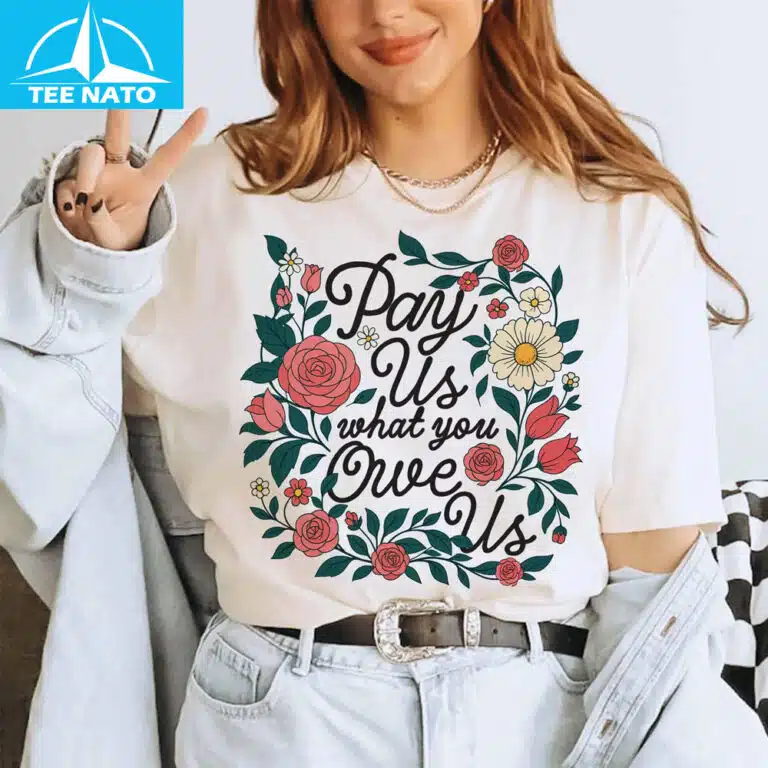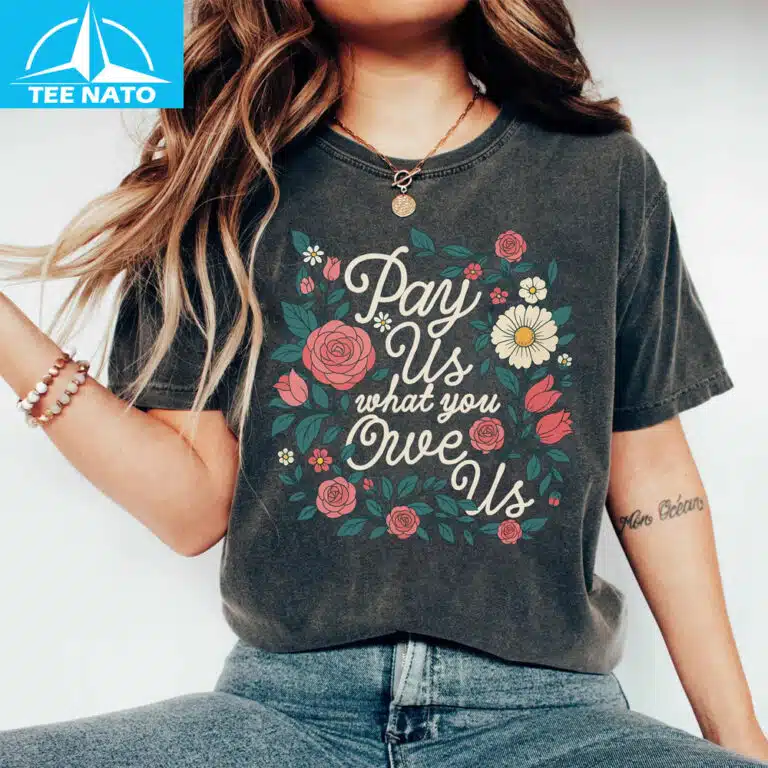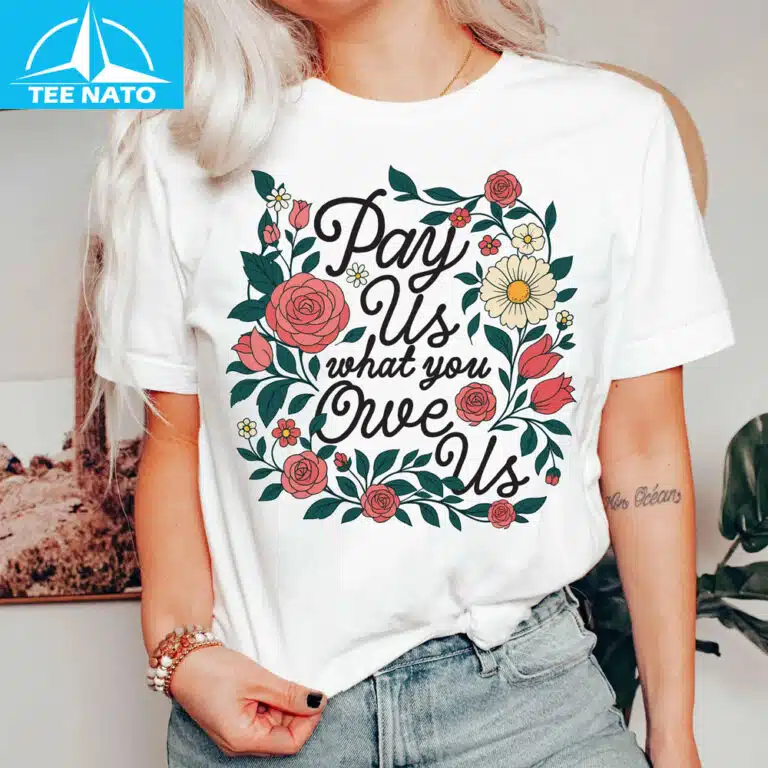The Force of Protest Clothing – The Significance of the “Pay Us What You Owe Us” Top
The Force of Protest Clothing – The Significance of the “Pay Us What You Owe Us” Top
The “Pay Us What You Owe Us” Top is more than just apparel—it’s a powerful declaration demanding fairness and accountability. Whether donned at protests, in daily routines, or as part of a collective effort, this top amplifies voices advocating for equitable pay, redress, or corporate responsibility.
Below, we explore its importance, how to style it, and its significant influence.
The Cultural Import of the “Pay Us What You Owe Us” Top
Fashion has always been a canvas for activism, and the “Pay Us What You Owe Us” Top is a modern emblem of resistance. It seamlessly merges style with conviction, transforming wearers into mobile advocates for economic justice.
A Symbol of Economic Justice Efforts
This top deeply resonates with labor rights champions, underpaid workers, and marginalized communities. Its message is universal—whether addressing unpaid wages, racial wealth disparities, or corporate exploitation.
By wearing it, individuals align themselves with movements striving for economic equity.

How It Differs from Generic Protest Garments
Unlike vague slogans, this top directly challenges systemic inequities. It is specific, bold, and refuses to dilute its demand for accountability.
Comparatively, abstract phrases like “Change Now” lack the same compelling urgency.

The Role of Social Media in Boosting Its Message
Viral moments have thrust the top into mainstream consciousness. Protesters wearing it at rallies often see their images shared widely, reinforcing the demand.
This digital exposure ensures the message extends beyond physical demonstrations.
Styling the “Pay Us What You Owe Us” Top for Optimal Effect
Activist fashion thrives when the message is unmistakable. Here’s how to make the “Pay Us What You Owe Us” Top truly stand out.
Pairing with Striking Accessories
- Bold jackets: A leather or denim jacket adds an assertive touch.
- Subtle jewelry: Keeps the focus firmly on the top’s message.
Avoid overly busy patterns that could distract from the crucial slogan.
Layering for Different Environments
For formal settings, layer it under a blazer to subtly introduce the message. At protests, wear it solo for maximum visibility.
Its versatility ensures it’s appropriate anywhere.
Footwear that Complements the Overall Vibe
Combat boots echo the top’s militant tone. Casual sneakers keep it relaxed yet purposeful.
Every choice should reinforce the top’s core purpose.
Real-World Examples Where the Top Sparked Change
From strike lines to courtrooms, the “Pay Us What You Owe Us” Top has left its indelible mark.
Labor Disputes and Union Drives
Amazon warehouse employees wore it during strikes for better wages. Its clarity cut through corporate public relations.
This visual solidarity strengthened collective bargaining efforts.
Racial Justice Demonstrations
Activists paired it with “Reparations Now” signs at BLM marches. It highlighted the intersection of racial and economic justice.
The top became a unifying symbol across various causes.
Corporate Accountability Actions
Shareholder meetings saw employees wearing it to confront executives. Its bluntness forced uncomfortable but essential conversations.
Even skeptics couldn’t ignore its direct call to action.
Comparisons: “Pay Us What You Owe Us” Top vs. Other Protest Attire
How does this top stack up against other forms of activist clothing?
Specificity versus Vagueness
Compared to “Advocate for Change,” this top clearly names the issue—unpaid earnings. Its precision makes it harder for opponents to dismiss.
Longevity of Message
Transient slogans fade; the pursuit of economic justice remains ever-relevant. This top’s demand transcends temporary viral moments.
Audience Reception
Politicians and CEOs react more intensely to direct claims. It’s designed to challenge entrenched power structures.
Practical Advice for Using the Top Effectively
Maximize its impact with these strategic approaches.
Choosing the Right Timing
Wear it at rallies, meetings with employers, or media interviews. Optimal timing ensures the message is not diluted.
Combining with Other Strategies
Pair it with petitions, public speeches, or social media outreach. Fashion alone won’t revolutionize systems—but it’s a powerful instrument.

Maintaining the Top’s Authenticity
Avoid altering the slogan to preserve its universal recognition. Consistency strengthens its association with the cause.
Conclusion
The “Pay Us What You Owe Us” Top is a potent fusion of style and activism, commanding attention where mere words might fail. Whether through intentional styling, compelling real-world examples, or comparisons to other protest wear, its power lies in its unyielding clarity. By integrating it into broader movements, wearers transform everyday clothing into a powerful catalyst for change. `
POSTER SEO_SIBATOOL




